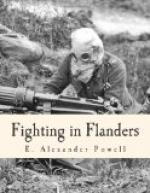Then occurred one of the bravest acts that I have ever seen. To reach them a messenger would have to traverse a mile of open road, swept by-shrieking shrapnel and raked by rifle-fire. There was about one chance in a thousand of a man getting to the end of that road alive. A colonel standing beside me under a railway-culvert summoned a gendarme, gave him the necessary orders, and added, “Bonne chance, mon brave.” The man, a fierce-moustached fellow who would have gladdened the heart of Napoleon, knew that he was being sent into the jaws of death, but he merely saluted, set spurs to his horse, and tore down the road, an archaic figure in his towering bearskin. He reached the troops uninjured and gave the order for them to retreat, but as they fell back the German gunners got the range and with marvellous accuracy dropped shell after shell into the running column. Soon road and fields were dotted with corpses in Belgian blue.
Time after time the Germans attempted to carry the railway embankment with the bayonet, but the Belgians met them with blasts of lead which shrivelled the grey columns as leaves are shrivelled by an autumn wind. By mid-afternoon the Belgians and Germans were in places barely a hundred yards apart, and the rattle of musketry sounded like a boy drawing a stick along the palings of a picket-fence. During the height of the battle a Zeppelin slowly circled over the field like a great vulture awaiting a feast. So heavy was the fighting that the embankment of a branch railway from which I viewed the afternoon’s battle was literally carpeted with the corpses of Germans who had been killed during the morning. One of them had died clasping a woman’s picture. He was buried with it still clenched in his hand. I saw peasants throw twelve bodies into one grave. One peasant would grasp a corpse by the shoulders and another would take its feet and they would give it a swing as though it were a sack of meal. As I watched these inanimate forms being carelessly tossed into the trench it was hard to make myself believe that only a few hours before they had been sons or husbands or fathers and that somewhere across the Rhine women and children were waiting and watching and praying for them. At a hamlet near Sempst I helped to bury an aged farmer and his son, inoffensive peasants, who had been executed by the Germans because a retreating Belgian soldier had shot a Uhlan in front of their farmhouse. Not content with shooting them, they had disfigured them almost beyond recognition. There were twenty-two bayonet wounds in the old man’s face. I know, for I counted them.




